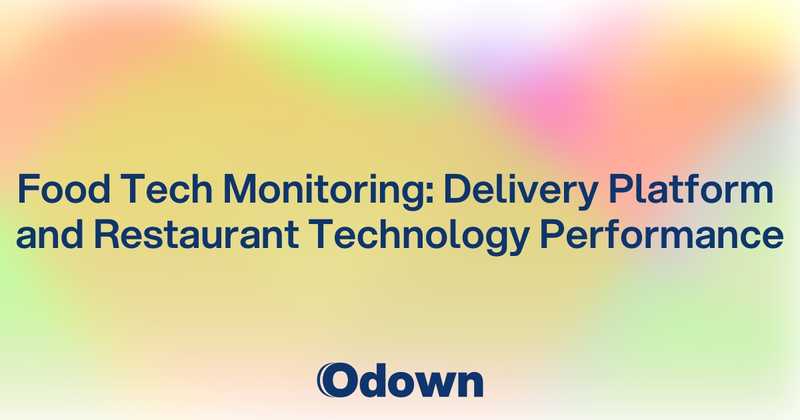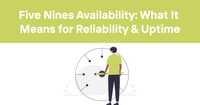Food Tech Monitoring: Delivery Platform and Restaurant Technology Performance
Your food delivery platform processes thousands of orders daily across hundreds of restaurants. Your monitoring dashboards show healthy servers and fast response times. Then the dinner rush hits and chaos erupts. Orders disappear from restaurant systems. Drivers can't find delivery addresses. Customers get charged for food they never receive. Your perfectly functioning technical infrastructure becomes a customer service nightmare.
The problems lurked beneath traditional monitoring: order integration with restaurant POS systems failed silently when order volumes spiked. GPS routing worked fine for main streets but failed in apartment complexes and new developments. Payment processing succeeded but order confirmations failed to reach restaurants during peak hours when kitchen display systems were overloaded.
Food technology monitoring requires understanding that failed orders don't just disappoint customers - they waste prepared food, cost driver time and fuel, and damage relationships with restaurant partners. Food delivery operates on tight margins with time-sensitive logistics where even brief technical issues can cascade into operational disasters that affect everyone in the ecosystem.
Food Delivery Platform Monitoring: Orders, Routing, and Delivery Tracking
Food delivery platforms coordinate complex ecosystems involving customers, restaurants, drivers, and logistics that require comprehensive monitoring to ensure smooth operations.
Order Processing and Management
Food order processing requires real-time coordination between customer apps, restaurant systems, and delivery logistics.
Order placement monitoring tracks the complete order workflow from customer app through restaurant confirmation and payment processing.
Order routing monitoring tracks how orders are assigned to restaurants and ensures that orders reach the correct restaurant locations.
Order modification monitoring tracks changes to orders including item substitutions, special requests, and cancellations that require coordination across multiple systems.
Order timing monitoring tracks promised delivery times and identifies bottlenecks that might cause delays throughout the fulfillment process.
Order accuracy monitoring tracks how order details are communicated to restaurants and ensures that customer requests are fulfilled correctly.
Restaurant Integration and Communication
Food delivery platforms must integrate seamlessly with diverse restaurant technology systems and operational workflows.
POS system integration monitoring tracks how delivery orders integrate with restaurant point-of-sale systems and kitchen workflows.
Menu synchronization monitoring tracks how restaurant menus, pricing, and availability information stay current across delivery platforms.
Order confirmation monitoring tracks how restaurants acknowledge orders and provide preparation time estimates.
Restaurant capacity monitoring tracks how many orders restaurants can handle simultaneously without compromising quality or delivery times.
Restaurant availability monitoring tracks restaurant hours, temporary closures, and capacity limits that affect order acceptance.
Delivery Logistics and Driver Management
Food delivery logistics require real-time optimization and coordination to ensure timely, efficient deliveries.
Driver assignment monitoring tracks how delivery orders are matched with available drivers based on location, capacity, and efficiency.
Route optimization monitoring tracks delivery routing algorithms and ensures that drivers receive efficient directions that minimize delivery times.
Multi-order delivery monitoring tracks how platforms optimize deliveries when drivers carry multiple orders simultaneously.
Delivery tracking monitoring tracks real-time delivery progress and provides customers with accurate delivery time estimates.
Driver performance monitoring tracks completion rates, delivery times, and customer ratings that affect driver availability and platform efficiency.
Customer Communication and Experience
Food delivery requires constant communication with customers who expect real-time updates about order status and delivery progress.
Order status notification monitoring tracks how customers receive updates about order confirmation, preparation, and delivery progress.
Delivery time estimation monitoring tracks accuracy of promised delivery times and identifies factors that cause delivery delays.
Customer support integration monitoring tracks how technical issues are escalated to customer service and resolved quickly.
Refund and compensation monitoring tracks how order issues are resolved and ensures fair resolution for customers and restaurant partners.
Restaurant POS System Monitoring and Integration
Restaurant point-of-sale systems serve as critical hubs that coordinate orders, payments, inventory, and kitchen operations.
POS System Performance and Reliability
Restaurant POS systems require high availability because system failures directly affect customer service and revenue.
Transaction processing monitoring tracks payment processing speed and reliability during peak dining periods.
Order entry monitoring tracks how quickly restaurant staff can input orders and modifications into POS systems.
Kitchen communication monitoring tracks how orders flow from POS systems to kitchen display systems and printing stations.
Table management monitoring tracks restaurant seating, reservation systems, and table turnover optimization.
Inventory integration monitoring tracks how POS systems update ingredient availability and menu item availability in real-time.
Payment Processing Integration
Restaurant payment processing must handle diverse payment methods while maintaining PCI compliance and operational efficiency.
Credit card processing monitoring tracks payment success rates and identifies issues that might prevent transaction completion.
Mobile payment integration monitoring tracks contactless payments, digital wallets, and mobile app payments that are increasingly popular.
Split payment monitoring tracks group dining scenarios where multiple customers contribute to single checks.
Tip processing monitoring tracks how gratuities are handled in electronic payment workflows.
Cash handling monitoring tracks cash drawer integration and ensures accurate cash management reporting.
Multi-Location Restaurant Monitoring
Restaurant chains require monitoring that provides both individual location visibility and corporate-level oversight.
Centralized menu management monitoring tracks how menu changes propagate across multiple restaurant locations.
Corporate reporting monitoring tracks sales, performance, and operational metrics across restaurant networks.
Franchise system monitoring tracks how different franchise operators use centralized systems and maintain brand standards.
Supply chain integration monitoring tracks inventory management and ordering systems that support multiple restaurant locations.
Third-Party Integration Monitoring
Restaurants integrate with numerous third-party services that require monitoring to ensure operational continuity.
Delivery platform integration monitoring tracks how restaurant POS systems communicate with multiple food delivery services.
Reservation system monitoring tracks table booking systems and ensures accurate availability information.
Loyalty program integration monitoring tracks customer rewards and ensures accurate point accumulation and redemption.
Accounting system integration monitoring tracks how sales data flows to financial systems for reporting and analysis.
Food Tech Mobile App Monitoring: Customer and Driver Applications
Mobile apps are critical for food delivery platforms because both customers and drivers depend on mobile functionality for ordering, delivery, and operational efficiency.
Customer Mobile App Performance
Food delivery customer apps must provide fast, reliable ordering experiences because hungry customers have low tolerance for technical issues.
Menu browsing performance monitoring tracks how quickly restaurant menus load and display with current pricing and availability.
Search and filtering monitoring tracks restaurant discovery features that help customers find desired food options.
Order customization monitoring tracks how customers can modify menu items and add special instructions or dietary preferences.
Checkout process monitoring tracks payment entry and order confirmation workflows that must work smoothly to complete transactions.
Order tracking monitoring tracks real-time delivery progress and provides customers with accurate delivery estimates.
Driver Mobile App Performance
Driver apps must provide efficient tools for delivery operations because driver productivity directly affects platform economics.
Order acceptance monitoring tracks how drivers receive and accept delivery orders through mobile interfaces.
Navigation integration monitoring tracks GPS routing and turn-by-turn directions that drivers need for efficient deliveries.
Delivery confirmation monitoring tracks how drivers confirm pickups and deliveries through mobile app interfaces.
Earnings tracking monitoring tracks driver compensation, tips, and payment processing for delivery services.
Driver support monitoring tracks how drivers can access help and support during delivery operations.
Offline and Network Resilience
Food delivery apps must function reliably even when network connectivity is limited or intermittent.
Offline capability monitoring tracks how apps function when drivers lose cellular connectivity during deliveries.
Data synchronization monitoring tracks how app data synchronizes when connectivity is restored after offline periods.
Battery optimization monitoring tracks how efficiently food delivery apps use device battery during extended work periods.
Network switching monitoring tracks how apps handle transitions between WiFi and cellular networks during delivery routes.
Real-Time Communication Features
Food delivery platforms require real-time communication between customers, drivers, and restaurants.
In-app messaging monitoring tracks communication between customers and drivers for delivery coordination.
Photo sharing monitoring tracks delivery confirmation photos and food quality images that customers and drivers exchange.
Real-time location sharing monitoring tracks how location information is shared between customers and drivers for delivery coordination.
Push notification monitoring tracks order updates, delivery alerts, and promotional messages that keep users engaged.
Kitchen Display System and Order Management Monitoring
Kitchen display systems coordinate food preparation and order fulfillment in restaurant environments that require precision timing and coordination.
Kitchen Workflow and Order Management
Kitchen display systems must integrate seamlessly with restaurant operations to ensure efficient food preparation and delivery.
Order queue monitoring tracks how orders are prioritized and displayed in kitchen workflows to optimize preparation timing.
Preparation time tracking monitoring tracks how long different menu items take to prepare and identifies bottlenecks in kitchen operations.
Order completion monitoring tracks when orders are ready for pickup or delivery and ensures timely handoff to delivery drivers.
Kitchen station coordination monitoring tracks how different preparation stations coordinate complex orders that require multiple components.
Order modification monitoring tracks how changes to orders are communicated to kitchen staff during preparation.
Inventory and Ingredient Monitoring
Kitchen operations require real-time inventory tracking to prevent stockouts and ensure menu availability.
Ingredient availability monitoring tracks inventory levels and automatically updates menu availability when ingredients run low.
Waste tracking monitoring tracks food waste and helps optimize ordering and preparation to reduce costs.
Recipe management monitoring tracks standardized recipes and ensures consistent food preparation across different shifts and staff.
Supplier integration monitoring tracks inventory ordering and delivery coordination with food suppliers.
Kitchen Performance Analytics
Kitchen display systems provide operational analytics that help optimize restaurant efficiency and food quality.
Order timing analytics monitoring tracks average preparation times and identifies opportunities for workflow optimization.
Kitchen capacity monitoring tracks how many orders kitchens can handle simultaneously without compromising quality.
Staff performance monitoring tracks individual and team productivity metrics that support training and operational improvement.
Quality control monitoring tracks food quality metrics and customer satisfaction related to food preparation.
Health and Safety Compliance
Kitchen monitoring must support food safety regulations and health compliance requirements.
Temperature monitoring tracks food storage and preparation temperatures to ensure food safety compliance.
Cleaning schedule monitoring tracks sanitization and cleaning workflows that maintain health department standards.
Food safety training monitoring tracks staff certification and training compliance for food handling requirements.
Health inspection preparation monitoring tracks data and documentation needed for regulatory compliance and inspections.
Food technology monitoring transforms restaurant and delivery operations from reactive problem-solving into proactive operational optimization that ensures consistent customer satisfaction and operational efficiency. Instead of discovering order failures after customers complain, you identify and resolve issues before they affect food quality or delivery times.
The investment in comprehensive food tech monitoring pays dividends in improved customer satisfaction, reduced food waste, and optimized delivery logistics that improve profitability for restaurants, drivers, and delivery platforms. You finally get the visibility needed to coordinate complex food service ecosystems that depend on precise timing and coordination.
Ready to implement comprehensive food tech monitoring? Odown provides restaurant and delivery-focused monitoring that tracks order workflows, POS integration, and mobile app performance alongside traditional uptime monitoring. Combined with our travel tech monitoring expertise, you'll have monitoring strategies that work for both time-sensitive logistics operations and complex booking and reservation systems.



